MSI Cubi 2 Kaby Lake UCFF PC Review
by Ganesh T S on December 30, 2016 3:30 PM ESTPower Consumption and Thermal Performance
The power consumption at the wall was measured with a 1080p display being driven through the HDMI port. In the graphs below, we compare the idle and load power of the MSI Cubi2-005B with other low power PCs evaluated before. For load power consumption, we ran the AIDA64 System Stability Test with various stress components, as well as our custom stress test with Prime95 and Furmark, and noted the maximum sustained power consumption at the wall.
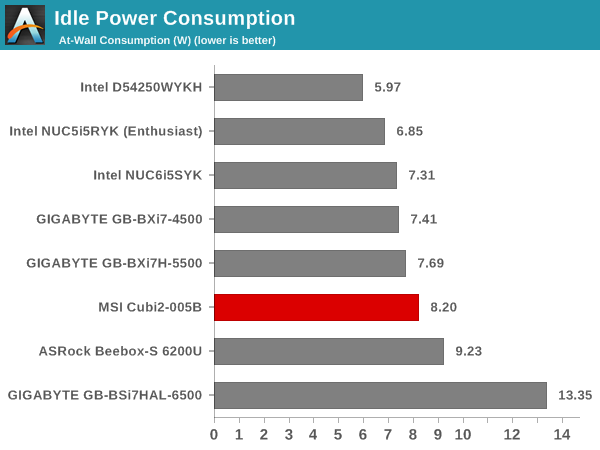
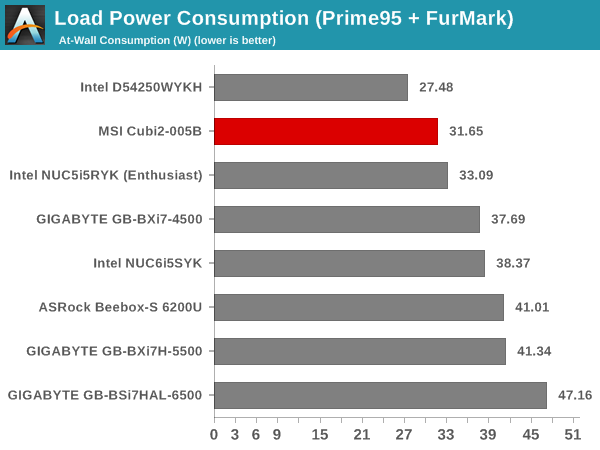
Even though Kaby Lake-U is touted to be very power efficient (and has been proved in some of the preceding sections), it looks like the BIOS could do with some tweaks for better idle power consumption. On the load side, we found Prime95 + Furmark providing the higher sustained power consumption number, as shown below in our thermal stress routine.
Our thermal stress routine starts with the system at idle, followed by four stages of different system loading profiles using the AIDA64 System Stability Test (each of 30 minutes duration). In the first stage, we stress the CPU, caches and RAM. In the second stage, we add the GPU to the above list. In the third stage, we stress the GPU standalone. In the final stage, we stress all the system components (including the disks). Beyond this, we leave the unit idle in order to determine how quickly the various temperatures in the system can come back to normal idling range. The various clocks, temperatures and power consumption numbers for the system during the above routine are presented in the graphs below.
We repeated the same observations with our legacy stress test using the latest versions of Prime95 and Furmark - Prime95 v28.10 for 30 minutes (after launching with the max. stress option), followed by Furmark v1.18.20 for 30 minutes. The Prime95 load is then removed, allowing just the GPU alone to be stressed for 30 minutes. The system is then left idle.
According to the official specifications, the junction temperature of the Core i7-7500U is 100 C. We find that the temperature is briefly reached with the Prime95 AVX2 workload. The package power also goes upwards of 20W in this case. However, the power limitation soon kicks in, and the package power is held stable at 15W throughout the stress workload. In the case of the AIDA64 SST (which is not pure AVX2 for the CPU stress case, but, more of an all-round test case), the package power is never more than 15W, and the core temperature stays around 80C.
On the whole, the Cubi 2's thermal solution is geared for a 15W TDP CPU. This is acceptable for almost all consumer use-cases, but, results in the performance numbers of the BRIX-series with cTDP-Up SKUs being better.


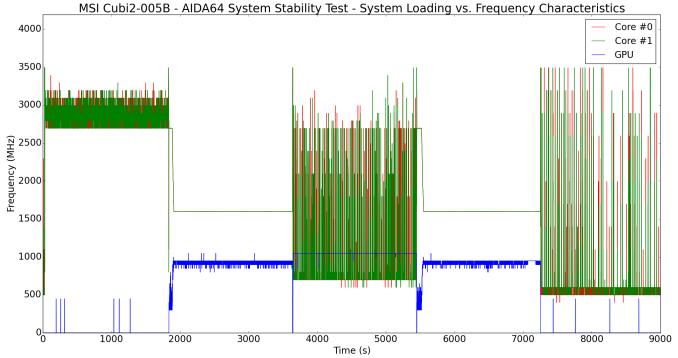
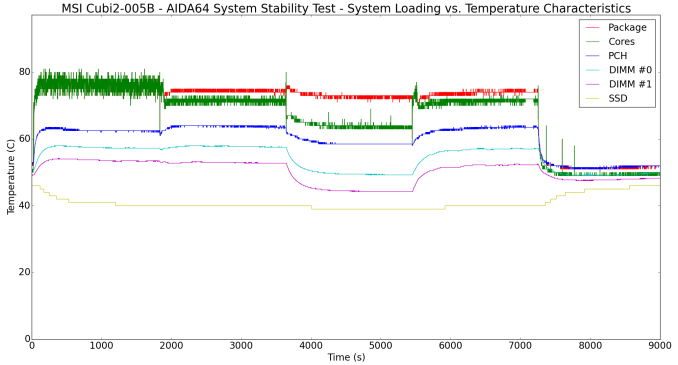

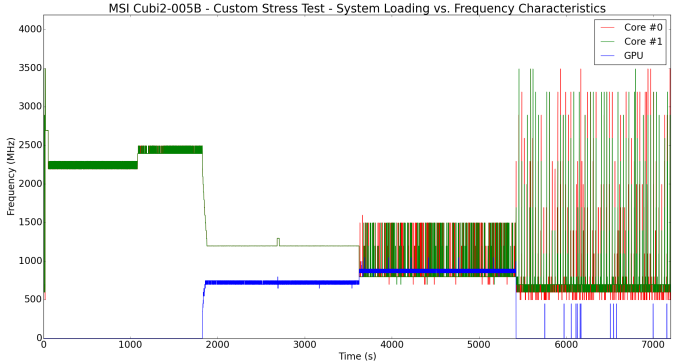

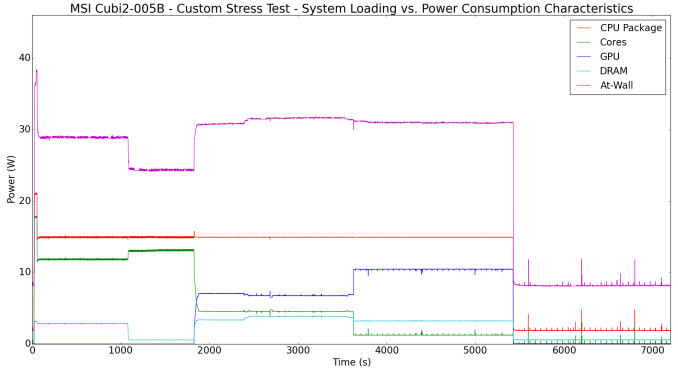








32 Comments
View All Comments
MrSpadge - Friday, December 30, 2016 - link
First paragraph:"The Kaby Lake-U (KBL-U)series with 15W TDP CPUs was introduced along with the 4.5W Kaby Lake-Y ones in Q3 2014."
You mean Broadwell here instead of Kaby Lake, don't you?
ganeshts - Friday, December 30, 2016 - link
bad typo, with the link in it correctly linking to the Q3 2016 article. It has been fixed.Voldenuit - Friday, December 30, 2016 - link
No tear down? Cooling system? System layout? Noise measurements?Great_Scott - Friday, December 30, 2016 - link
It doesn't really matter anyways.This kind of system is a waste of time: laptops have greater functionality for less price, and the same components. The U-series doesn't distinguish between the i5 and i7 beyond clock speeds.
You can go to any site online and get a U-series laptop for ~$400 US that also includes RAM and Storage.
barleyguy - Saturday, December 31, 2016 - link
For an HTPC, a NUC or UCFF is a lot more convenient than a laptop. They generally have less fan noise, fit in less space, and boot up with the TV (or projector) as the primary monitor.(I'm typing this on a Zotac Z-Box in my living room.)
That said, I'm really skeptical of the U-series processors in general. My Z-Box has an i5-4200u, and I've had some issues with throttling under load. Hopefully they've improved from the 4200u to the 7500u.
kmmatney - Monday, January 2, 2017 - link
and the laptop will have an OS as well...milkod2001 - Tuesday, January 3, 2017 - link
and it also has screen, keyboard and tracking device to start with and usually cost much less.I can only see good use of NUCs if the cheapest & crappiest NUCs are considered to buy to replace Intel P4 10 years old machines with existing monitors, keyboards and mice. For anything else: laptop is much better solution unless you need to Vesa mount your computer on telly.
niva - Tuesday, January 3, 2017 - link
I don't know about all that, please show me the laptop with a Kaby Lake "i7" chip and comparable specs that really stacks up to this NUC and obsoletes it.I think these boxes are ideal for installing linux on it, paying for a windows license when buying a laptop really irks me anyways so that's money down the drain too. I just bought an Acer Aspire E 15 from Amazon for $350 but that thing had a terrible drive in it, an i3-7100U, and only a single stick of 4GB RAM. Of course I had an old SSD from my previously dead laptop I could put in and I dumped linux on it which is fine with 4GB of RAM at this point, but you guys are seriously ignoring some of the components thrown into this NUC.
BrokenCrayons - Tuesday, January 3, 2017 - link
*shoulder taps* Psst, from one Linux user to another, Windows licenses are not a waste because close to or over 99% of laptops that ship with Windows end up as ....*drum roll*... Windows latops.As far as your Acer's sad configuration is concerned, welcome to the wonderful world of budget computers. You got what you paid for. If you want better new hardware, you'll have to dig a little deeper into the wallet.
ganeshts - Friday, December 30, 2016 - link
You guys are hard to please. In any case, this is a bog standard NUC, nothing special about it.Cooling system - all that matters is effectiveness, and I hope readers agree when I say that we have the most comprehensive evaluation of the effectiveness of the cooling solution of mini-PCs in the review circuit. Look at the graphs in the 'Power Consumption and Thermal Performance' section.
Noise measurement - we only do subjective eval in these reviews. Providing noise numbers for these types of PCs (i.e, non gaming mini-PCs) is pretty much useless because the noise floor is too high and these types of PCs are too quiet in our evaluation setup. Creating a noise measurement lab is not worth the investment for the number of PC reviews that I do per year. You can find dedicated guys like SPCR ( Silent PC Review - http://www.silentpcreview.com/ ) who fill that market niche with excellent reviews and articles. (I would imagine even they would not find the Cubi 2 and other similar PCs interesting enough to do noise measurements)